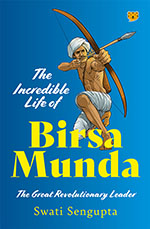Birsa Munda, a popular hero in Jharkhand, is not so well-known in the rest of the country. We are grateful to Swati Sengupta for presenting this hero of the Independence movement to the Indian reader. The author has described, in detail, the life of the brave youth who dared to fight against the powerful British, and the landlords whom they patronized.
Jharkhand was a part of Bihar and became a separate State in the year 2000. The original inhabitants of this hilly, forest region were tribals, who roamed freely in the land, until the British took over. They introduced the new system of Permanent Settlement, under which intermediaries were appointed as landlords who collected land revenue from the tenants and deposited it with the British Government. The land rights of the Munda tribals were weakened and they were reduced to labourers working for others.
Birsa’s father, Sugana Munda, was a labourer, moving from place to place, looking for work to help support his family. He soon moved to Chalkhad in Khunti district of Jharkhand, the village of Birsa’s mother. After Birsa’s primary education in schools nearby he was admitted into a German missionary school at Chaibasa. Here he learnt English and became a Christian. After four years there, he left and began working at Bandgaon as an agricultural labourer. He stayed with Anand Panre under whose influence he became a Vaishnavite. At Bandgaon he also learnt about the problems the Mundas faced. The land policies of the British were destroying the old system and moneylenders and zamindars were taking over the tribals’ lands. The village headmen, the Sardars were rebelling, leading the fight against the British and their unfair rules.
 He was arrested and put in jail.
He was arrested and put in jail.
The two years in jail made Birsa even more popular. Once again people began to gather around and listen to him. His words soon sowed the seeds of an uprising in the minds of his followers. An ideal hiding place, amidst the forest hills and valleys, became the home of the rebels, who formed a guerilla army to fight the unfair rulers. Meetings were held and attacks planned against British rule. Birsa was chased from one hiding place to another, and rewards were announced to catch him. Finally, he was caught while asleep in a hut. He was tried, sentenced, and thrown into a jail in Ranchi. Shortly after, the police declared that he had died of cholera.
Birsa became a hero. His revolt forced the Government to recognize the rights of the tribals and make laws to protect them. He continues to be a symbol of Adivasi pride. His statues decorate important crossroads in the cities of Jharkhand. Sengupta has related the story of Birsa Munda in a simple but effective style.
Jhalkari Bai, the Dalit woman who fought alongside Rani Laxmibai of Jhansi and helped protect her from being attacked by the British. But not many historians tell us much about this courageous woman.
All those who have read about Rani Laxmibai of Jhansi, who fought the British in 1857, have admired the brave queen. Jhalkari Bai, a soldier in her army, is mentioned briefly as the woman who was chased by the British army while the Rani escaped through another gate. That is all that we know about Jhalkari Bai.
The author tells us much more. Jhalkari Bai was born in a Dalit family in village Bhojla, not far from Jhansi. While still a girl, she managed to kill a tiger that attacked her in the jungle, where she had gone to collect wood for her kitchen choolha. In another incident, she chased away three dacoits whom she saw stealing in a neighbour’s house. The two incidents impressed everyone in the village.
Jhalkari had no interest in domestic chores like cooking, but loved horse riding, sword fighting and shooting. Her father, proud of his brave daughter, encouraged her. Later, her husband, Puran Kori, a soldier in Jhansi, also encouraged Jhalkari. Together, the two would go riding and practice shooting and sword fighting.
Meanwhile, as the author writes, the King of Jhansi, Gangadhar Rao had died. Laxmibai now ruled on behalf of their adopted son. Like Jhalkari, the Queen, too, was skilled at horse riding and sword fighting. Jhalkari admired the young queen and was thrilled when Puran took her one day to meet her. To the surprise of both, they found that Jhalkari had a striking resemblance to Laxmibai. Rani Laxmibai invited Jhalkari to join the women’s army, Durga Dal, that she had formed. Impressed by her skills and power, Laxmibai soon appointed her as its leader.
The British attack on Jhansi began not long after. Jhalkari led the Durga Dal and fought bravely. The attack continued for several days, and many lives were lost. At last, the British succeeded in overpowering the Indians. As the attackers began to enter Jhansi, a plan was made.
The Queen must escape so that she could return with greater strength to fight the British again. Jhalkari would dress up as the Queen and fool the attackers while the Rani escaped through another gate. That is exactly what happened. Jhalkari was taken to be the fleeing Queen and chased while Laxmibai rode out to safety.
What happened to the Rani is well known but Jhalkari’s story is not so clear. Some say she died fighting; others, that she was caught but set free and lived on. Jhalkari’s story may not find a place in history books but is still told in the area where she lived.
As with her other books on historical characters, the author has told the story well. Jhansi, its palace and fort, and the surrounding area are described vividly. Jhalkari does not remain a shadowy figure. In the author’s hands, she gets her place in history.
November 2023, volume 47, No 11

